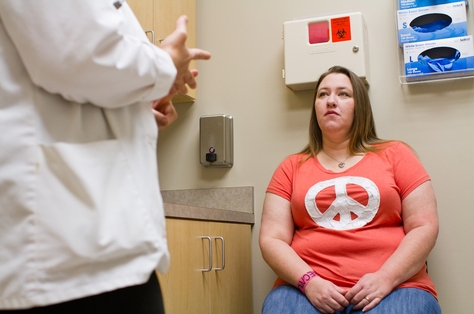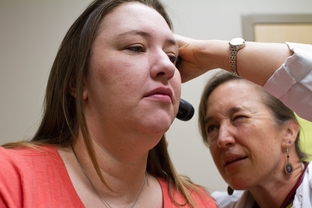
At campaign stops and in the three debates he’s participated in so far, Republican presidential hopeful Gov. Rick Perry has made a sport out of bashing former Massachusetts Gov. Mitt Romney’s 2006 state health insurance plan. He’s missed no chance to yoke “Romneycare” to “Obamacare,” the federal health care reform Republicans largely revile.
But while Perry condemns both efforts to make carrying health insurance mandatory, his home state of Texas faces a staggering crisis in health coverage: Texas leads the nation in the size of its uninsured population, has the third-lowest percentage of people covered by their employers, and spends less per capita on Medicaid, the joint state-federal insurance program for the disabled and poor children, than all but one other state.
In the 10 years Perry has been governor, his critics say there have been few effective initiatives out of his office to significantly increase either public or private health coverage in Texas, where today, an estimated 6.2 million people — one quarter of the state’s population — are uninsured, 1.3 million of them children.
“He can pin the tail on the donkey, and basically say ‘Romneycare’ was ‘Obamacare,’” said Dr. Ron Anderson, the president and chief executive of Parkland Health and Hospital System, Dallas’ public hospital and its main health care provider to the poor. “The truth is, they both need to be tweaked and improved. But we can’t tout the Texas model. At least Romney tried.”
Perry’s office says the governor has gone to great lengths to help Texans get insured through the free market, without the “misguided approach” of forcing them to purchase coverage. His aides did not offer a number for how many Texans have obtained health insurance due to his efforts, saying many of the initiatives were relatively new.
Instead, they say the governor’s health care strategy is to encourage job creation and foster an environment of personal responsibility, not government dependence. “Texas measures its health care success by the options that are provided for coverage, and the efforts to create ones that are affordable,” said Perry spokeswoman Catherine Frazier. “Ultimately, it is the consumer’s choice whether to utilize these options.”
To that end, his aides tout legislation he signed to let insurers offer lower-cost, smaller-scale health plans to consumers, to let single-employee businesses join health care cooperatives, and to help employers pay for their workers’ health care without negative tax consequences.
During his tenure, Texas created a health insurance pool to sell policies to people with uninsurable medical conditions, Perry’s office says, and received a multimillion-dollar federal grant to develop tools to increase private insurance coverage.
Texas comes into the health insurance game at a disadvantage. Perry likes to remind voters that Texas is responsible for more than 40 percent of new jobs created in America since June of 2009. But many of those jobs are in the service industry, in agriculture, construction and the small business sector, which either don’t provide insurance, or don’t pay their workers enough to purchase it. Texas Medicaid is austere — many low-income Texans who might qualify for public insurance in other states don’t qualify in Texas.
Just 50 percent of Texans get insurance through their employers, 10 percentage points below the national average. And though health insurance premiums in Texas are slightly below the national average, they have nearly doubled in the last decade. Despite suggestions that Texas’ illegal immigrants are to blame for the sky-high rate of the uninsured, they make up just one-sixth of the total, according to an analysis by the left-leaning Center for Public Policy Priorities (CPPP).
Perry’s critics say the state’s Republican leadership has compounded the crisis by treating health coverage as a “gated community,” where people who can’t pull themselves up by their bootstraps aren’t entitled to care. They’ve chipped away at Medicaid rates paid to physicians and providers, curbed eligibility for state health services in tough budget years, and cut funding for loan repayment and medical education for fledgling doctors.
Perry and Republican leaders have fought efforts to implement federal health reform in Texas at every turn. Meanwhile, the growing ranks of the uninsured have placed extraordinary burdens on Texas’ health care providers, including cash-strapped public hospitals and clinics.
“Year after year, session after session, they’ve looked at health care not as an investment in our community, but as something they resent doing, like a social welfare item,” said Austin-based health policy consultant Kim Ross.
Perry’s staff says Texas provides an adequate safety net to those “truly in need.” But in 2003, in the face of a massive budget shortfall, he supported the Legislature’s decision to slash the state’s Children’s Health Insurance Program, eliminating coverage for more than 200,000 kids, or 40 percent of those enrolled. (It took seven years to restore CHIP enrollment to its pre-2003 level.)
In another effort to cut costs that year, the state authorized privatizing the eligibility and enrollment systems for CHIP, Medicaid and Food Stamps, leading to mistaken rejections and much-delayed services. The projected savings never materialized, and the state was forced to cancel the contract.
Following a 2007 “State of the State” address where Perry proposed a plan to provide affordable insurance to two million working-poor Texans largely at the federal government’s expense, he sought a waiver that would’ve redirected hundreds of millions of dollars slated for uncompensated care to a low-income insurance pool. That pool would’ve provided monthly premium assistance to help people buy their own insurance.

The waiver, which Perry said would’ve made the private insurance market more robust “without a government takeover of your health care and without adding one more Texan to the government rolls,” wasn’t approved by the Bush administrations, which had concerns that it would curb Medicaid eligibility and enrollment. (Another Medicaid waiver proposal sent to the Obama administration this year, one that has received initial approval, wouldn’t increase health insurance coverage, but is aimed at helping safety net providers care for the uninsured.)
Asked about Texas’ poor insurance rate in a recent Republican debate, Perry said of Medicaid waivers: “We know for a fact that given that freedom, the states can do a better job of delivering health care and you’d see more people, not just in Texas but all across the country, have access to better health care.”
Arguably the most successful private health insurance initiative of the last decade is the 2009 Healthy Texas program, aimed at helping small businesses provide insurance to their employees. The program was appropriated $35 million over the 2010-11 biennium with the goal of covering at least 20,000 people once it was fully implemented. To date, just 5,000 people are covered, but Perry’s office says enrollment has grown every month since last September.
Anne Dunkelberg, the CPPP’s associate director, said the program holds great promise. But she said it’s just one small piece of the state’s giant health insurance conundrum.
“The administration seems to have prioritized limiting public investment in coverage and minimizing private market regulation over reducing the Texas uninsured rate,” she said.
